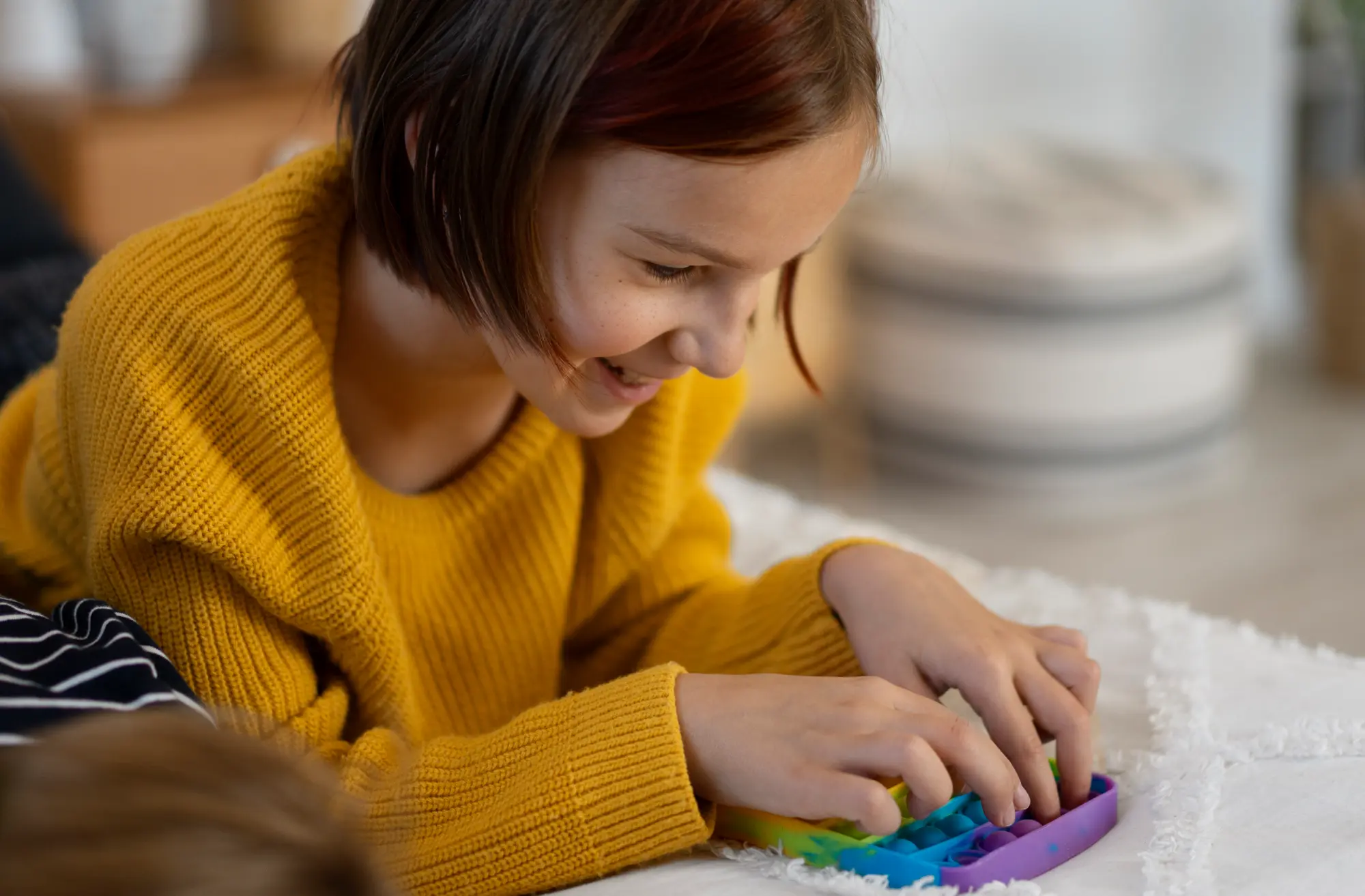What Is Pairing in ABA Therapy?

One of the first and most important steps in applied behavior analysis (ABA) therapy is helping your child build a positive connection with their therapist. This is called pairing. Before any new skills are taught, the therapist focuses on earning your child’s trust and showing them that therapy can be fun and rewarding. Pairing sets the stage for learning by turning the therapist, therapy setting, and even tasks into things your child enjoys.
Definition of pairing in ABA therapy
In ABA therapy, pairing is the process of turning something neutral, like a therapist, classroom, or learning task, into something your child enjoys. To do this, the therapist “pairs” themselves with things your child already loves, like a favorite toy, game, or snack.
At first, your child might not know what to expect from a therapist or therapy setting. There are no positive or negative feelings attached yet. By consistently offering enjoyable things during sessions, the therapist helps your child start to associate them with fun, comfort, and rewards.
Over time, your child begins to enjoy spending time with their therapist, even before toys or snacks are involved. That strong, positive bond is what makes future learning possible.
ABA therapy techniques: Why is pairing important?
Pairing helps lay the groundwork for everything else in ABA therapy. When your child feels happy, safe, and motivated, it becomes easier to build new skills and reduce frustration. Here’s what effective pairing can do:
- Turns therapy into a positive experience by connecting it with fun and rewarding activities
- Helps your child build trust in the therapist and therapy space
- Increases motivation so your child wants to participate, not just for the reward but because they enjoy the interaction
- Creates lasting connections that make learning smoother and more enjoyable
Pairing isn’t something that happens just once. It’s a process that continues naturally during ABA therapy sessions. Here’s how it usually works:
1. Find what the child enjoys
The first step is learning what the child likes or finds fun. These things are called “preferred reinforcers." They could be favorite toys, games, snacks, or even spending time with certain people. Knowing what makes the child happy helps the therapist connect with them.
2. Use those favorites to start pairing
Next, the therapist pairs themselves with the things the child enjoys. That means the therapist spends time with the child while they are playing with a favorite toy or eating a favorite snack. Over time, the child begins to see the therapist as someone fun and positive.
3. Create positive associations
As sessions go on, the child starts to link the therapist with fun times. Things like the therapist’s voice, the way they act, and how they play all help the child feel more comfortable and connected.
4. Add simple tasks slowly.
Once the child feels comfortable around the therapist, the therapist can begin asking the child to try easy, everyday tasks, such as picking up a toy, stacking a block, or pointing to a picture in a book. These tasks are kept simple at first, and the therapist continues to use fun and positive rewards to keep the child motivated and happy while learning.
Five things BCBAs do for effective pairing
Effective pairing takes time, patience, and a compassionate approach to care. Here are five common strategies ABA therapists use to help make pairing successful:
They keep things fun and interesting
Pairing works best when the child is having a good time. Therapists try to make activities enjoyable so the child feels relaxed and excited to be there. This could include playing silly games, giving high-fives or praise, or doing things the child already likes. When it feels like play, the child is more likely to join in and stay engaged.
They’re consistent
Doing things the same way each time helps build trust. The therapist should always connect themselves and therapy activities with things the child enjoys. For example, if the child loves bubbles, the therapist might blow bubbles during playtime. When this happens over and over again, the child starts to see the therapist as someone fun and positive.
They use natural rewards
It’s helpful to use positive reinforcement that already makes sense for the situation. For example, if a child loves a certain toy, the therapist can use that toy as a reward for trying a task. If a child smiles when they’re praised, the therapist should give lots of encouragement during play and learning.
They know when to use fewer rewards
At first, the therapist might give rewards often, like toys, snacks, or praise. But as the pairing becomes stronger, they can slowly give fewer of these things. The goal is for the child to enjoy working with the therapist, even when a favorite toy isn’t always offered. The child learns that just being with the therapist can be fun too.
Most of all, they’re patient
Pairing doesn’t happen right away. It takes time to build trust and create a positive bond. Rushing can make things harder. Therapists need to stay calm, be compassionate, give the child space to get comfortable, and let the connection grow naturally. With patience, children learn to enjoy time with their therapist, which in turn encourages more meaningful outcomes.
Examples of ABA therapy pairing activities for therapists & families
Pairing activities help the therapist build a fun, positive relationship with the child. These activities are based on what the child already enjoys. Here are a few common examples used during ABA therapy sessions:
- Toy play: The therapist joins the child in playing with their favorite toys, like blocks, bubbles, or cars. Instead of giving instructions right away, the therapist focuses on having fun together.
- Snack time: If the child has a favorite snack, the therapist can offer small bites while sitting nearby or during a short, easy activity. This helps the child associate the therapist with something they already enjoy.
- Music and movement: For children who enjoy music, the therapist might sing, dance, or play a favorite song. They might pause the music to get the child’s attention, then restart it as a fun reward.
- Simple games: Fun games like “Peek-a-Boo,” “Simon Says,” or “Catch” are great ways to bond with the child. These games can include short instructions to help ease into future learning tasks.
- Sensory activities: If the child enjoys activities like swinging, jumping, or playing with water or sand, the therapist can join in or help make the experience even more fun. This helps the child feel safe and connected.
- Reading or watching short videos: Some children enjoy being read to or watching a favorite cartoon. A therapist might sit with the child during this activity to build trust and comfort.
What a successful pairing looks like in ABA therapy
Pairing is the process of helping your child build a positive relationship with their therapist. Here’s a simple example of what that might look like during a session:
1. Find what your child loves
- Action: Sarah loves playing with her toy truck and enjoys apple slices as a snack. Her therapist will use these as motivators during their time together.
- Tip: Let your therapist know about your child’s favorite toys, snacks, or games. Your input helps make sessions more successful.
2. Build the connection
- Action: The therapist joins Sarah in playing with the truck and offers lots of encouragement, like “Great job!” while having fun together.
- Tip: Social praise, like smiles, clapping, or high-fives, helps your child feel comfortable and enjoy the time with their therapist.
3. Start adding simple tasks
- Tip: After a few minutes of playing, the therapist says, “Can you hand me the truck?” When Sarah does, she gets a slice of apple and more praise.
- Over time, the therapist will ask your child to try simple tasks. As trust builds, rewards will be used less, and your child will be more excited to learn.
What are the long-term benefits of pairing in ABA therapy?
Pairing helps your child feel safe, understood, and excited to learn. Some long-term benefits of pairing include:
- More participation: Your child is more likely to join in activities and try new things when they enjoy being with their therapist.
- Less stress: Tasks feel less overwhelming or stressful when they're connected to fun, comfort, and encouragement.
- Better progress: A strong bond makes it easier for your child to learn important everyday skills that help them grow and succeed in therapy and beyond.
Start with ABA therapy at Action Behavior Centers
At Action Behavior Centers, we know how important it is for your child to feel safe, happy, and connected during therapy. That’s why we focus on pairing and building a positive relationship between your child and their therapist right from the start. Through play, encouragement, and your child’s favorite activities, we create a fun and trusting environment that helps your child stay engaged and reach milestone moments.
We offer evidence-based ABA therapy in center locations in multiple states, and we don’t have waitlists, so your child can get started right away. We also provide no-cost autism assessments to help guide your next steps. Contact us today to schedule a tour.
At Action Behavior Centers (ABC), we help children diagnosed with autism spectrum disorder (ASD) reach milestone moments. Compassionate care is at the heart of everything we do, and our highly trained clinicians deliver evidence-based applied behavior analysis (ABA) therapy tailored to each child’s unique needs.
Our autism services include diagnostic support, 1:1 individualized care, parent training, school readiness programs, and Early Intensive Behavioral Intervention (EIBI) across hundreds of centers in Arizona, Colorado, Illinois, Minnesota, North Carolina, and Texas. Because no family should have to wait for help, ABC offers immediate access to care. Contact us today to get started.


Join our newsletter
Stay in the loop with tips, events, and resources for families and clinicians. We’ll email you about once a quarter, and you can unsubscribe anytime.
More posts on:

How Long Does ABA Therapy Last?
At ABC, we provide evidence-based ABA therapy in-center for children ages 18 months to 8 years old, and our ABC Academy program serves school-age children ages 5 to 12. One of the most common questions parents ask is: Once my child begins, how long does ABA therapy last? The answer depends on your child’s unique needs and goals.

Is ABA Therapy Covered by Insurance?
If you’re exploring applied behavior analysis (ABA) therapy for your child, one of the first questions that often comes up is: “Will my insurance cover ABA therapy?” Understanding how insurance works with ABA therapy is a crucial part of planning and can help bring peace of mind.

Why We Use CentralReach to Track Progress in ABA Therapy
Discover how Action Behavior Centers uses CentralReach to deliver personalized, data-driven ABA therapy for children with autism. Learn how real-time progress tracking, goal setting, and smart reporting help families stay informed and involved every step of the way. Better tools mean better outcomes — explore how CentralReach supports your child’s growth and development.
Your child is accepted here
At Action Behavior Centers, we provide applied behavior analysis (ABA) therapy, a gold standard approach for helping children with autism. Our evidence-based therapies are carefully crafted to meet your child’s needs and unlock their strengths and abilities.


